- Published on
The Ultimate Guide to Shopify A/B Testing in 2025
- Authors

- Name
- Tony Chen
Introduction
As your Shopify store grows, attracting more visitors and sales, you eventually reach a stage where further growth no longer comes from more traffic—but from better conversions. Rather than focusing solely on acquiring new customers, many successful merchants turn to A/B testing to fine-tune their site experience, messaging, and pricing to drive more revenue from the same traffic.
In fact, studies show that 77% of businesses use A/B testing to improve conversions, and 60% run tests specifically on landing pages to optimize performance. If you’re serious about growing your Shopify store in 2025, then A/B testing is no longer optional—it’s essential.
What is A/B Testing (and Why It Matters for Your Shopify Store)
A/B testing (also called split testing) is a method of comparing two versions of a webpage or element to see which one performs better. You show Version A to half of your visitors and Version B to the other half, and then measure which one leads to more conversions—like purchases, clicks, or sign-ups.
On Shopify, this could mean testing different product images, pricing strategies, descriptions, or even the checkout flow. A/B testing removes the guesswork from design and marketing decisions—it lets real user behavior tell you what works best.
Before using A/B testing, many merchants rely on guessing what customers might like—be it layout, product image style, or messaging. But these guesses are often hit-or-miss, and rarely lead to the best conversion rate.
That’s why A/B testing is essential. It replaces guesswork with data, helping you optimize every detail of your store based on real customer behavior—not assumptions.
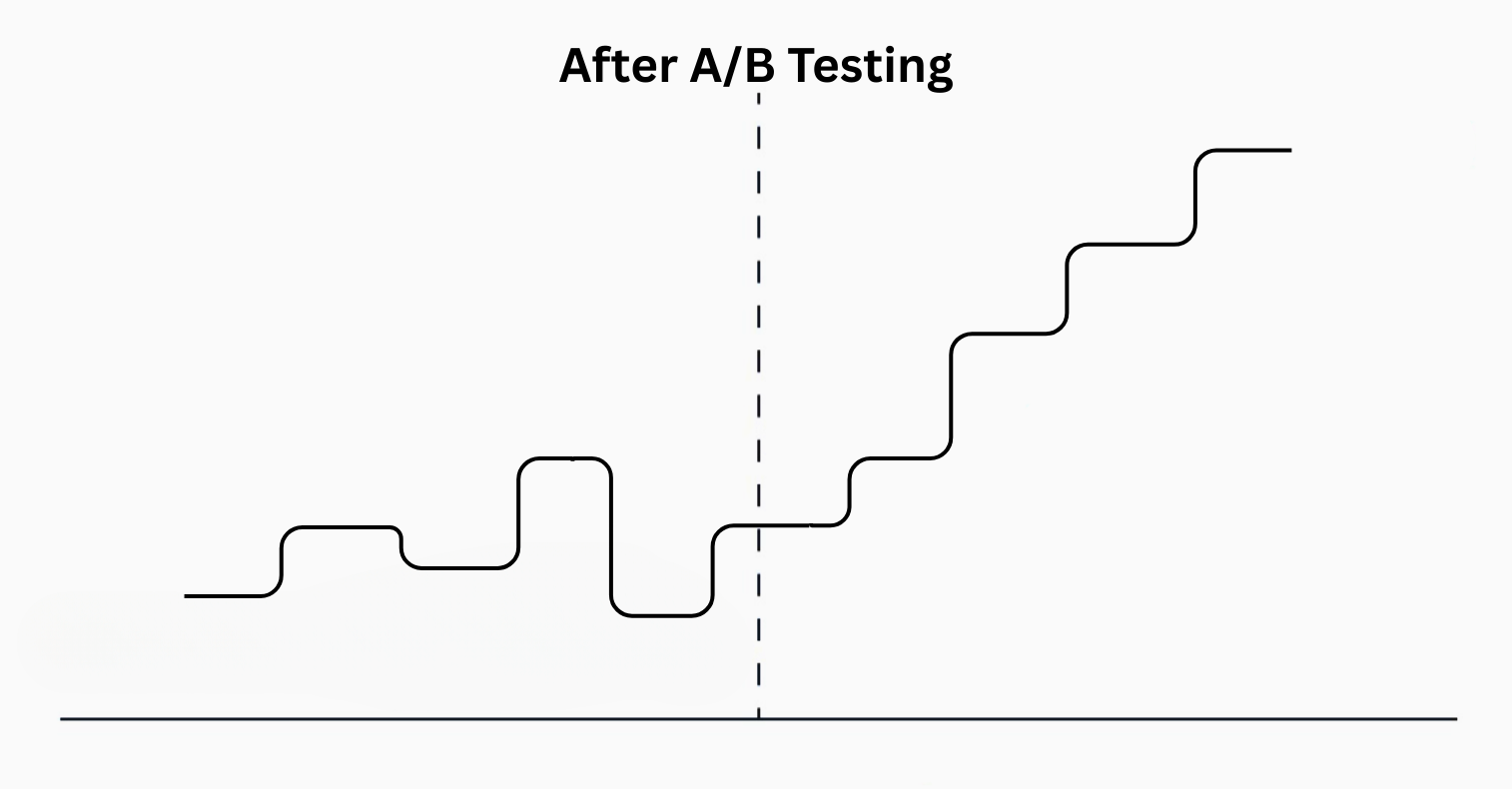
Pro tip: Improving your conversion rate through A/B testing can have a significant long-term impact on your store’s growth.
The Key Benefits of A/B Testing for Your Store
A/B testing is one of the most powerful tools available to Shopify merchants who want to grow their business with precision and confidence. Rather than guessing what might work, you can test different versions of your content, layout, pricing, and messaging to see exactly what resonates with your audience.
Here’s how A/B testing can transform your Shopify store:
Keep visitors engaged – Try out different headlines, product descriptions, or visuals to see what captures attention and keeps people browsing.
Lower your bounce rate – Identify which layouts or messages encourage visitors to stay instead of clicking away.
Convert more shoppers – From product images to CTA buttons, testing lets you fine-tune the elements that move people from browsing to buying.
Recover more abandoned carts – Small tweaks to your checkout process, like trust signals or clearer shipping info, can help more customers complete their purchase.
Grow your email list faster – Optimize your popups, lead forms, and signup incentives to get more visitors to subscribe or opt in.
Over time, these small improvements add up—resulting in significantly more revenue without having to increase your traffic. In a competitive ecommerce landscape, data-driven decisions aren’t just helpful—they’re essential. A/B testing gives you the clarity and control you need to continuously grow your store with confidence.
Real-World Examples of Shopify A/B Testing
Let’s look at some real-life A/B testing examples that have helped Shopify merchants increase their sales:
Product Images: A food brand tested two product photo styles: plain studio shots (Version A) versus lifestyle photos showing the product in use (Version B). The lifestyle version led to a significantly higher conversion rate—visual storytelling matters more than you might think.
Call-to-Action (CTA) Buttons: A merchant changed the CTA text from “Add to Cart” (Version A) to “Buy Now” (Version B). The new version led to a noticeable increase in click-throughs and checkout initiations. Even small wording tweaks can have a big impact.
Review Section: By simply adding a product review section to their product page, one merchant saw a 110% increase in revenue. This small change highlights just how powerful a single A/B test can be—sometimes, even the smallest tweak can drive massive results.
Pricing Strategy: One fashion brand tested a slightly lower price on their best-selling item (Version B), compared to their usual pricing (Version A). While the average order value dropped, total purchases increased—resulting in higher total revenue.
Checkout Flow: Another store experimented with a one-page checkout flow versus the traditional multi-step checkout. The simplified version reduced abandonment and improved completion rate by over 7.5%.
These examples prove that small, data-driven changes can lead to major results. A/B testing allows you to refine your store in ways you may not have even considered before.
Pro tip: For accurate results, make sure to test only one change at a time, and let your test run long enough to collect meaningful data.
What You Can A/B Test on Shopify
Nearly every part of your Shopify store that influences customer behavior can be A/B tested. Here are some of the most impactful elements you can experiment with:
Product Page Images & Videos: Try different product angles, backgrounds, or swap out static photos for lifestyle shots or product demo videos. You can also test showing an autoplaying video as the first media to see if it increases add-to-cart rates.
Product Titles & Descriptions: Words matter. You can test short vs. long product titles, keyword-rich vs. emotional descriptions, bullet points vs. narrative storytelling—and see which ones drive more conversions.
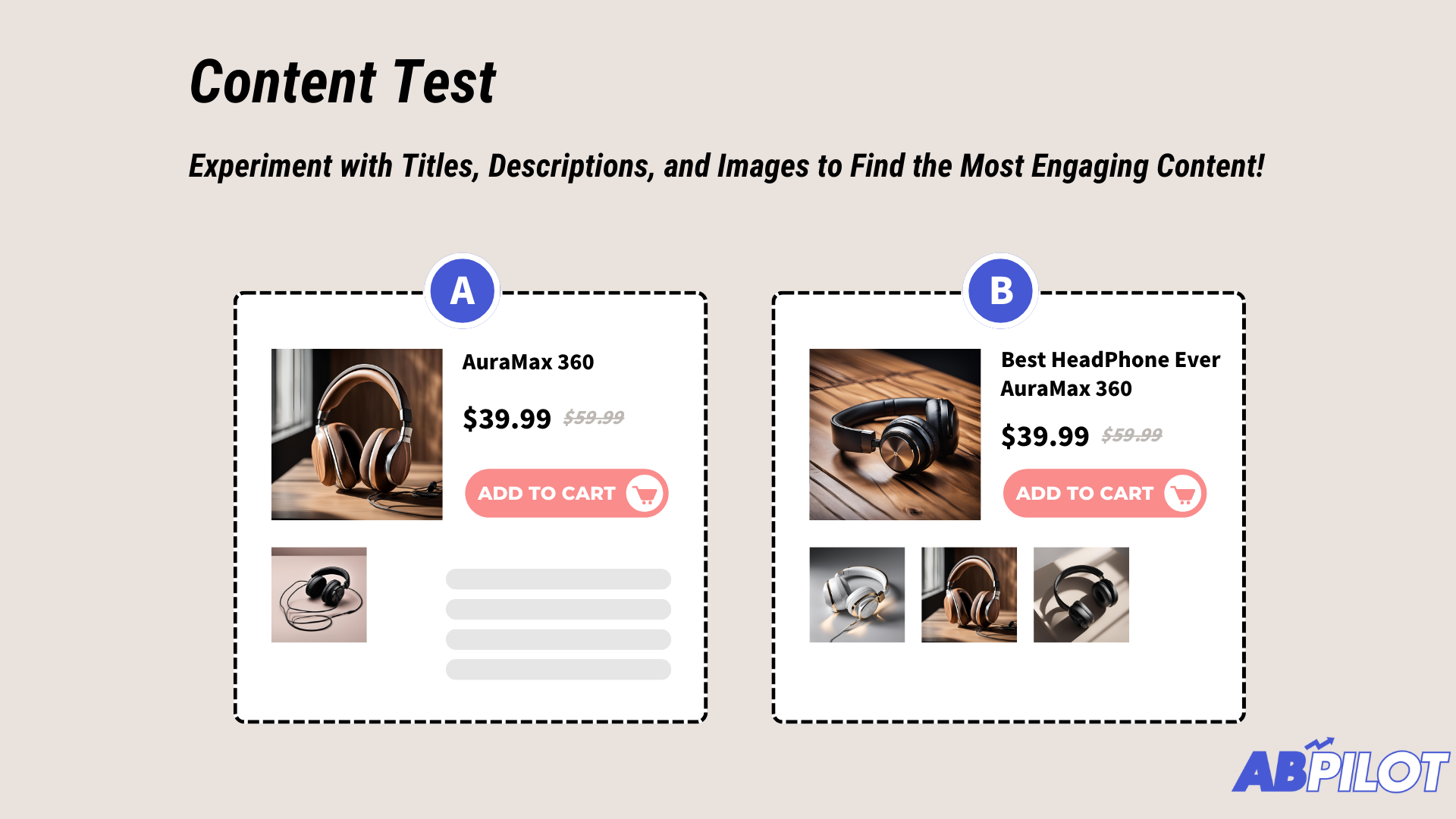
- Pricing Strategy: Test different product prices. You might find the optimal balance between conversion rate and profit margin through careful experimentation.
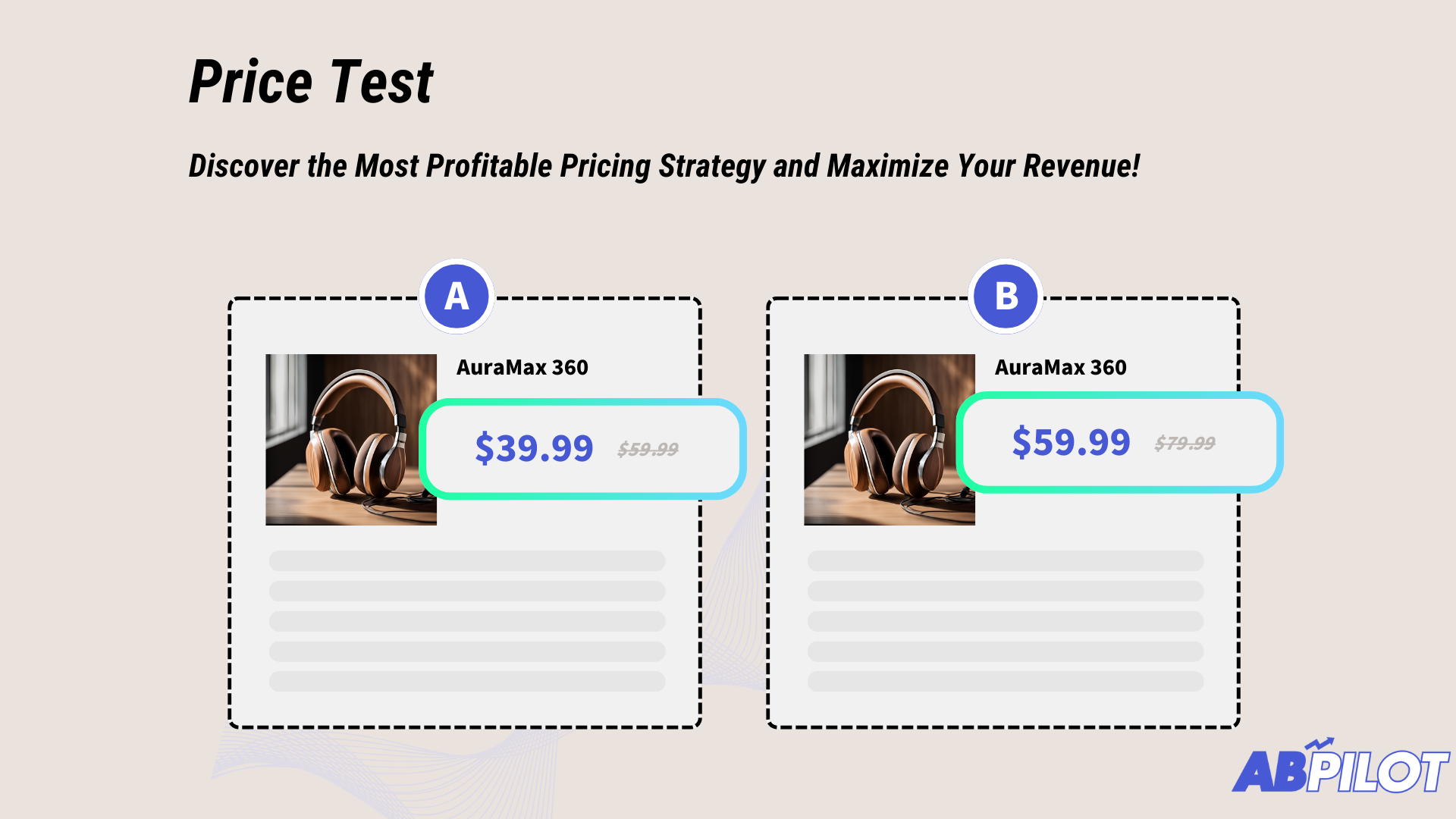
CTA Button Text, Color, and Placement: Try variations like “Add to Cart” vs. “Get Yours Today” vs. “Buy Now.” Test different button colors or reposition them on the page. A subtle change in your CTA can lead to significant improvements in user actions.
Homepage Layout: Try different hero images, messaging styles, promotional banners, or navigation headlines. For example, test a “free shipping” announcement vs. a “20% off” message—see which drives more product views or sales.

- Landing Page: Testing different landing pages can lead to dramatically different results. Even small changes—like the headline, layout, or imagery—can impact how visitors engage, how long they stay, and whether they convert.
The key is to start small, test one thing at a time, and let the data guide your decisions.
Start your A/B testing journey with ABPilot
ABPilot A/B Testing is a tool that helps you run A/B tests on your Shopify store. It's easy to use and gives you the data you need to make the right decisions.
Running a Price A/B Test with ABPilot
ABPilot offers a wide range of A/B testing tools for Shopify, including price tests, content tests, and landing page tests. To give you a clearer picture, let’s walk through a simple example using a price test:
- Install ABPilot and open it from your Shopify admin.

Choose Price Test from the test options.
Enter your experiment name and select the product you want to test.

- Input the price variations you want to compare — that’s pretty much all you need to get started.
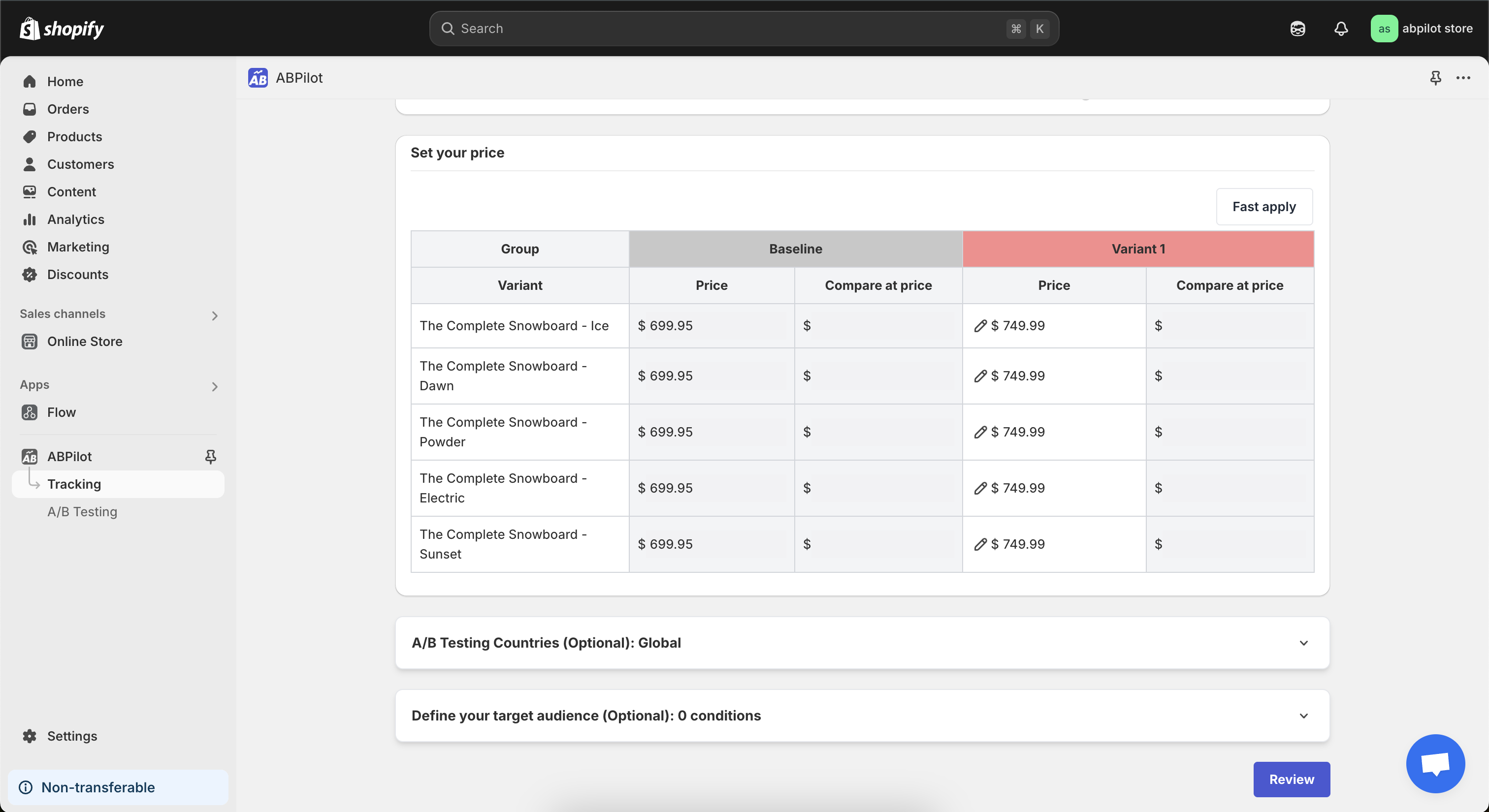
(Optional) You can also target specific customer segments or countries by filling in advanced settings.
Click Review to confirm your setup.
Before launching, you can Preview the test on your live store to ensure everything looks good.
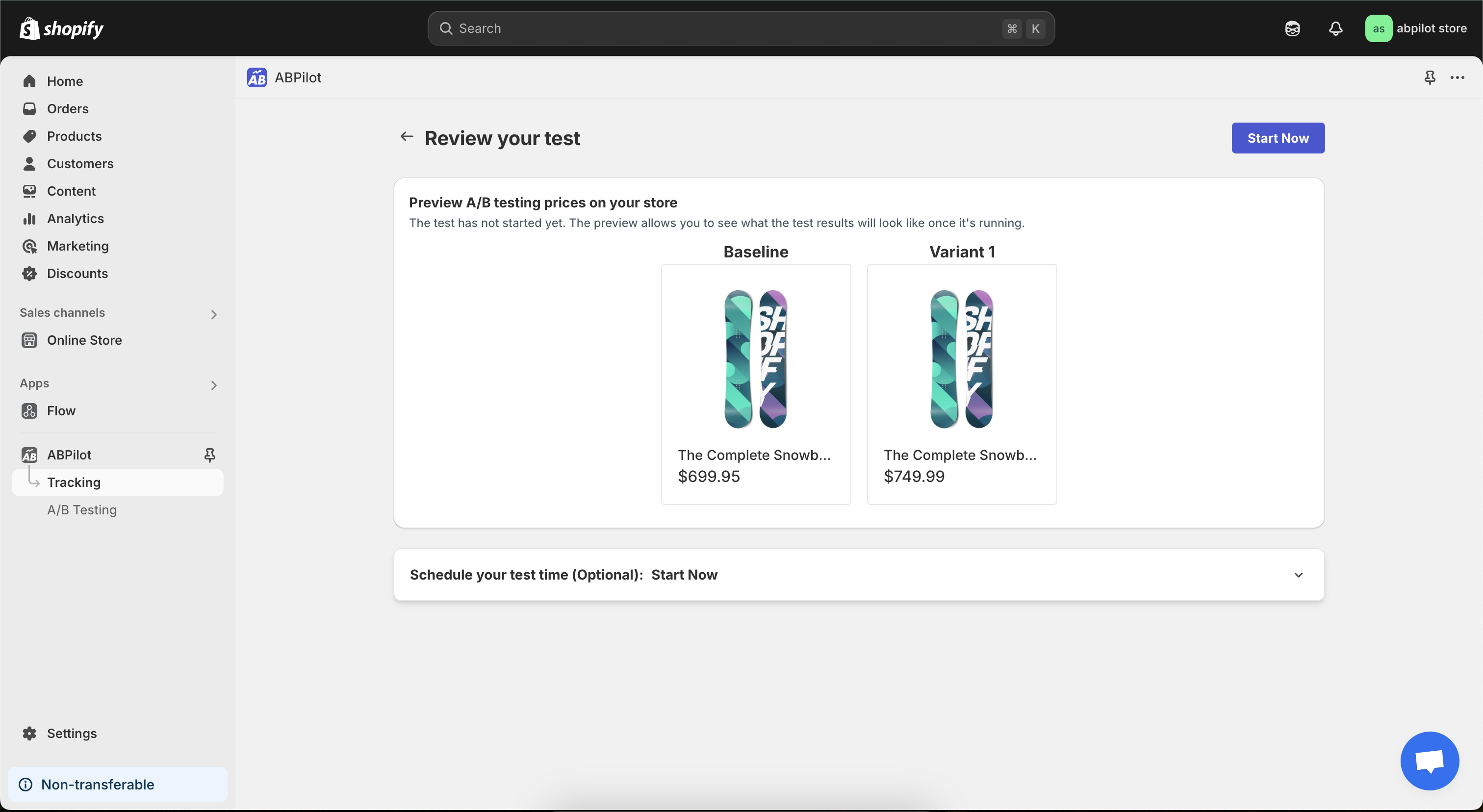
Hit Start Now to begin the test.
You’ll be redirected to the Analytics page, where you can monitor performance and wait for significant results.
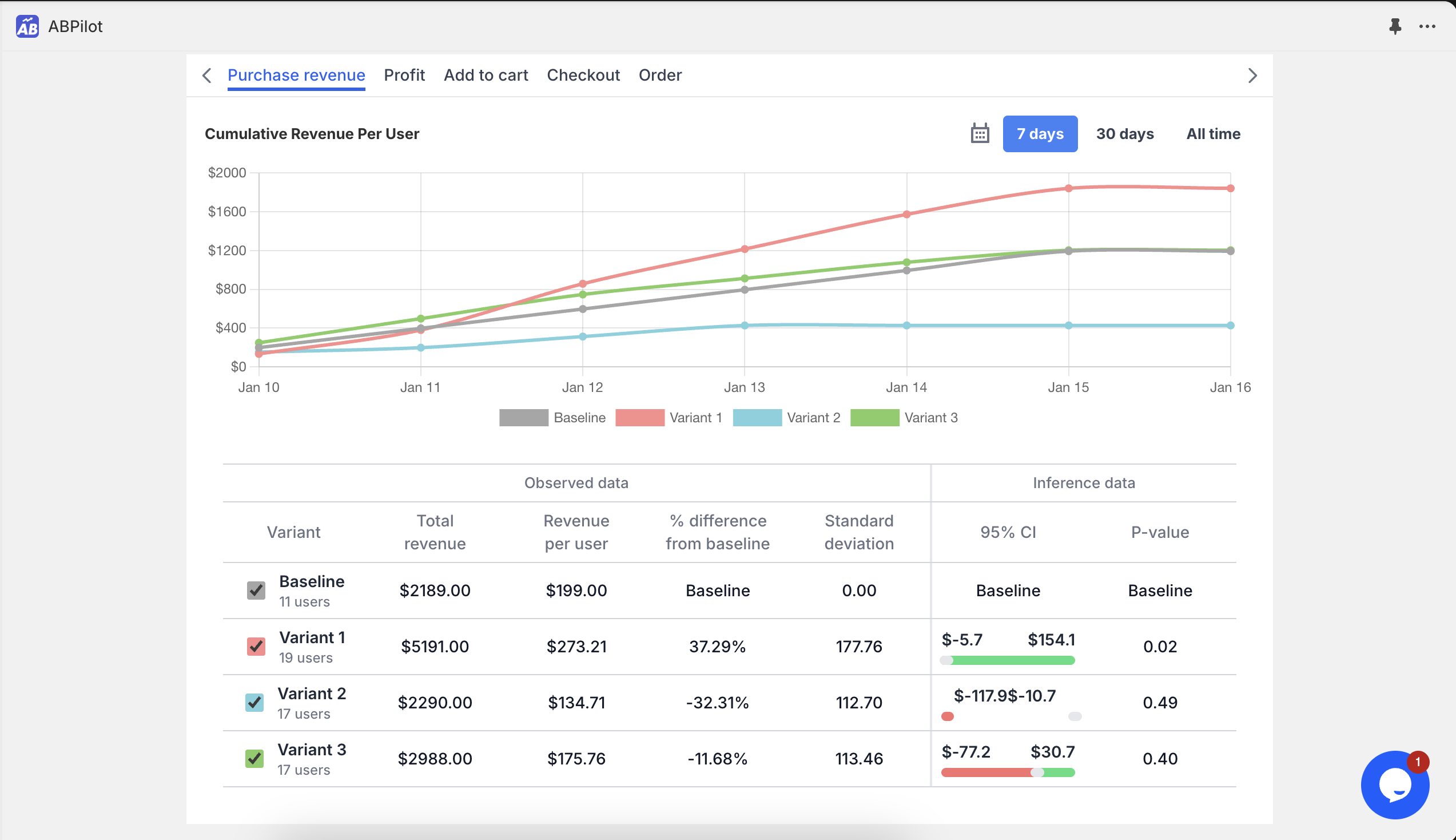
A simple setup like this lets you quickly test which price point converts better—no coding required, just actionable insights.
ABPilot also provides merchants with a built-in analytics dashboard that tracks all the key performance metrics—revenue, profit, add-to-cart rate, and other important conversion data. Through this analytics page, you can gain deeper insights into how your store is performing and continuously refine your strategy based on real results.
Conclusion
Once your Shopify store reaches a certain level of maturity, A/B testing becomes one of the most effective ways to grow. Rather than guessing what works, you’ll use real customer data to make better decisions, improve UX, and drive more sales.
Start with small, focused tests—run them for enough time to get meaningful results, and always test just one thing at a time. Over time, you’ll build up a data-driven strategy that delivers compounding improvements in revenue and customer experience.
It’s time to treat your store like a lab—run experiments, learn from the data, and optimize with confidence. With the right A/B testing approach, every click, scroll, and conversion is an opportunity to grow.
Frequently Asked Questions about Shopify A/B Testing
What is the best A/B testing app for Shopify?
While there are several great options, ABPilot is one of the most beginner-friendly tools with a full suite of features including pricing, content, and landing page tests.
How long should I run an A/B test?
It depends on your traffic volume, but most tests should run for at least 2–4 weeks to collect statistically significant data.
Can I run multiple A/B tests at once?
It’s best to run one test at a time per page to isolate variables and avoid skewed results.
Is A/B testing only for big stores?
Not at all! Even small Shopify merchants can benefit from testing different layouts, copy, or pricing to learn what works best for their audience.
